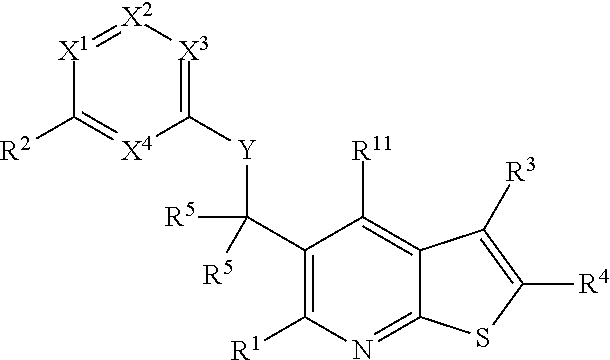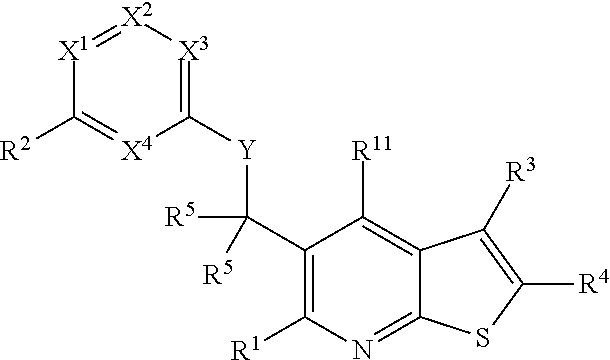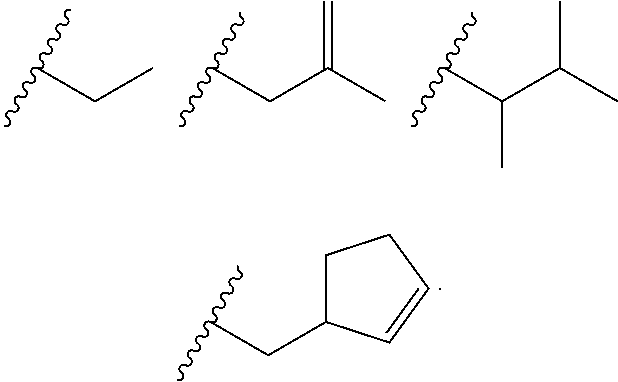Heterocyclic compounds and their uses
a technology of heterocyclic compounds and compounds, applied in the field of heterocyclic compounds and their, can solve the problems of limited utility of these compounds in studying the roles of individual class i pi 3-kinases, compounds, and non-specific pi3k inhibitors
- Summary
- Abstract
- Description
- Claims
- Application Information
AI Technical Summary
Benefits of technology
Problems solved by technology
Method used
Image
Examples
example 1
1-(2-Bromo-6-chlorothieno[2,3-b]pyridin-5-yl)ethanol
[0125]
[0126]To a solution of 2-bromo-6-chlorothieno[2,3-b]pyridine-5-carbaldehyde (2.4 g, 8.7 mmol) (Meth-Cohn, O. Narine B. Tetrahedron Lett., 1978, 2045) in THF (50 mL) at −20° C. was added methylmagnesiumchloride (3.04 mL of 3N in THF, 9.1 mmol) dropwise. The reaction was stirred at −20° C. for 45 minutes and then quenched with 25 mL NH4Cl (sat) and 25 mL of water. The reaction was diluted with ether and the layers were separated. The organic layer was washed with brine and concentrated. Purification by column chromatography afforded 1-(2-bromo-6-chlorothieno[2,3-b]pyridin-5-yl)ethanol. LC / MS (M+1, found=293.8). 1H NMR (400 MHz, CDCl3) δ 8.21 (s, 1H), 7.30 (s, 1H), 5.32 (qd, J=6.3, 2.7 Hz, 1H), 2.19 (br s, 1H), 1.55 (d, J=6.3 Hz, 3H) ppm.
2-(1-(2-Bromo-6-chlorothieno[2,3-b]pyridin-5-yl)ethyl)isoindoline-1,3-dione
[0127]
[0128]To a round-bottomed flask containing 1-(2-bromo-6-chlorothieno[2,3-b]pyridin-5-yl)ethanol (2.0 g, 6.8 mmol)...
example 2
1-(2-Bromo-6-chlorothieno[2,3-b]pyridin-5-yl)ethanone
[0137]
[0138]A 2.2 g (7.5 mmol) portion of 1-(2-bromo-6-chlorothieno[2,3-b]pyridin-5-yl)-ethanol was dissolved in toluene and treated with manganese dioxide (6.5 g, 75 mmol, 10 eq). The mixture was heated to 90° C. overnight, then cooled rt and filtered through Celite™. The filter cake was rinsed with toluene and concentrated to afford crude material. The residue was purifed by column chromatography using ethyl acetate in hexanes to afford 1-(2-bromo-6-chlorothieno[2,3-b]pyridin-5-yl)ethanone. LC / MS (M+1, found=291.9). 1H NMR (400 MHz, CDCl3) δ 8.17 (s, 1H), 7.36 (s, 1H), 2.75 (s, 3H) ppm.
(R)-1-(2-Bromo-6-chlorothieno[2,3-b]pyridin-5-yl)ethanol
[0139]
[0140]In 30 mL of THF was dissolved (+)-dip-chloride(tm) (3.3 g, 10.2 mmol, 2.2 eq) and the resulting solution was cooled to −55° C. To this solution was added 1-(2-bromo-6-chlorothieno[2,3-b]pyridin-5-yl)ethanone in 10 mL of THF via cannula, followed by a rinse with 10 mL of THF. The r...
example 3
(E)-1-(5-Chlorothiophen-2-yl)ethanone oxime
[0149]
[0150]Combined 1-(5-chlorothiophen-2-yl)ethanone (100 g, 622 mmol), hydroxylamine hydrochloride (47.6 g, 685 mmol, 1.1 eq) and sodium acetate (56.2 g, 685 mmol, 1.1 eq) in 1 L of ethanol and 300 mL of water. The reaction was heated to reflux. After 3 h, the reaction was cooled to rt and concentrated. The residue was slurried in 500 mL of water overnight, filtered and dried to afford the crude solid. Purified by extraction of the solid with hot dichloromethane, cooling to rt and filtering to remove unreacted starting material. The solid was slurried in hot dichloromethane several times to extract the solid enriched in the first eluting (E-oxime) compound (100% DCM) after concentration. The highly crystalline material was purified by column chromatography using 100% dichloromethane to afford (E)-1-(5-chlorothiophen-2-yl)ethanone oxime. NMR (400 MHz, DMSO-d6) δ 11.31 (s, 1H), 7.21 (d, J=3.9 Hz, 1H), 7.07 (d, J=3.9 Hz, 1H), 2.12 (s, 3H) p...
PUM
| Property | Measurement | Unit |
|---|---|---|
| temperature | aaaaa | aaaaa |
| concentration | aaaaa | aaaaa |
| volume | aaaaa | aaaaa |
Abstract
Description
Claims
Application Information
 Login to View More
Login to View More - R&D
- Intellectual Property
- Life Sciences
- Materials
- Tech Scout
- Unparalleled Data Quality
- Higher Quality Content
- 60% Fewer Hallucinations
Browse by: Latest US Patents, China's latest patents, Technical Efficacy Thesaurus, Application Domain, Technology Topic, Popular Technical Reports.
© 2025 PatSnap. All rights reserved.Legal|Privacy policy|Modern Slavery Act Transparency Statement|Sitemap|About US| Contact US: help@patsnap.com



